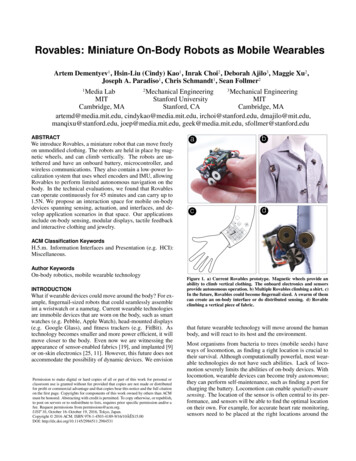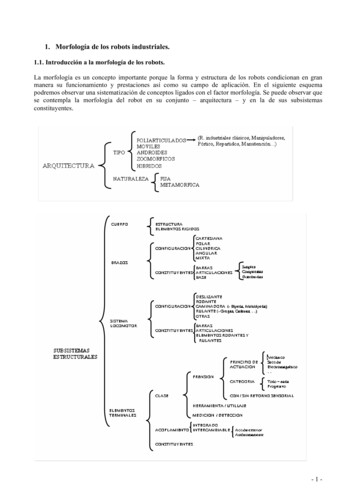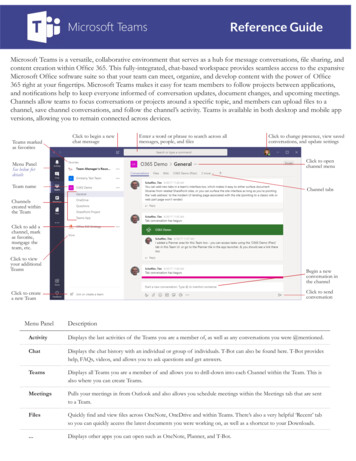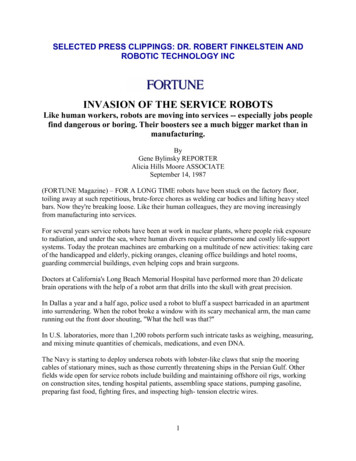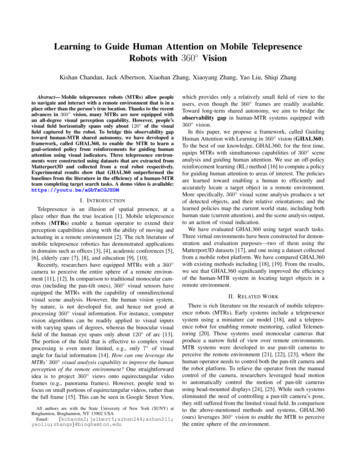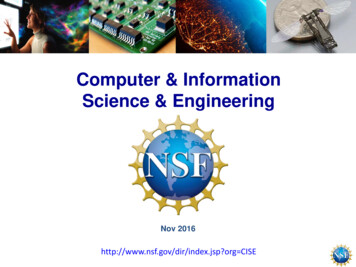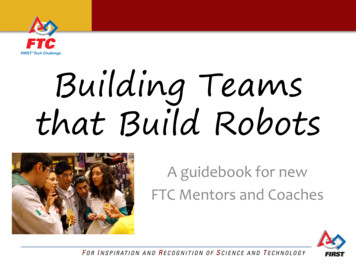
Transcription
Building Teamsthat Build RobotsA guidebook for newFTC Mentors and Coaches
Thank youMentors and Coachesprovide the glue thathold FTC Teams together.We value and appreciate you!
FTC Program GoalsTo show students that STEM subjects andproblem-solving are not onlyfun and rewarding, but areproven paths to successfulcareers and a bright future forus all; the value of hard work,innovation and creativity; and the importance of workingtogether, sharing ideas andtreating each other withrespect and dignity.
Life Skills“Participants report strong, positive impacts on their knowledge, interests, attitudesand skills.More than 90% of the Team members reported learning more about how science andtechnology can be used to solve problems in the real world; that the subjects theylearned in school have real-world applications; and the importance of being able tocooperate and compete with the same people using Gracious Professionalism; 85% ormore reported learning about the kinds of jobs people do that use science andtechnology.Eighty percent (80%) or more also reported that they were more interested in doingwell at school, plan to take more challenging math or science courses, and were moreinterested in going to college.A high percentage of participants– generally over 90% -- also reported learning criticallife and workplace skills through the program, including teamwork, interpersonal/negotiation skills, planning and problem-solving, time management, andcommunications and presentation skills.”--FTC/FRC Cross-Program Evaluation–Final ReportCenter for Youth and Communities, Brandeis University, September 2011
Gracious Professionalism At FIRST, Team members help other Team members, but they alsohelp other Teams.Professionals possess special knowledge and are trusted bysociety to use that knowledge responsibly.Gracious professionals make a valued contribution in a mannerpleasing to others and to themselves.In the context of FIRST, this means that all Teams and participantsshould: Learn to be strong competitors, but also treat one anotherwith respect and kindness in the process. Avoid leaving anyone feeling as if they are excluded orunappreciated. Knowledge, pride, and empathy should be comfortably andgenuinely blended.
Why Teambuilding? Teambuilding is an important skillset to help students besuccessful in the “real world”. Students will learn from each other as well as from Mentorsand Coaches. When people are comfortable, they are more willing to takerisks and can handle failure better. Students will develop the ability to network and makeconnections with others.A better understanding and appreciation for others is criticalin the global world we live in. Sharing ideas leads to more ideas and greater innovation. Students will build life-long friendships that brings meaningand value to the work they are doing together.
TogetherEveryoneAchievesMore but HOW do Mentors and Coaches build Teams?
TogetherBuild relationships– Create Team identity Motto/cheer Logo(s) T-shirts/costumes– Rituals and patterns Team check-ins Annual event(s) Regular social meeting (not just about building robots!)– Have Fun! Teambuilding activities: get students to intermingle and besilly together
Everyone Have a process to ensure equality within thegroup. Celebrate all skills and abilities. Ensure each person has an equal say in decisions. Gently curb students with dominant personalities. Encourage students with softer personalities. Recruit new members (as long as the Team sizestays manageable).
Achieves Every member has a role; Each role depends on the others;and Students are encouraged to take onnew roles. Everyone contributes to theEngineering Notebook. There are opportunities foreveryone to shine and berecognized.
More Set Team goals both for the group and for the annualcompetition(s). Troubleshoot problems right away, but work with thestudents to solve the issue. Provide feedback that is positive and constructive. Gradually release responsibility of the team over tothe Team. Have Team meetings to discuss the Team’s progressand comfort level. Reach out and give back to the Community and otherTeams.
Building FTC Teams Start at the first meeting – even before you have thematerials. Get the group engaged in an activity (nonrobot-building!). Participate. Role modeling is the best way to get thestudents to participate or to see the value of theactivity. Incorporate robot-building and non-robot-buildingactivities into your group’s routine. Students learn in a variety of ways, so varyteambuilding activities, too. Have some that arephysical, intellectual, creative, etc.
Building FTC Teams Incorporate student interests. If you have a student who ispassionate about soccer, find a away to get the Team to beengaged in soccer for at least one day. Or baking. Or music. Orwhatever. Make it about the students, all the students, and notthe adults. Observe who is a natural leader and who is more reserved. Asthe year progresses, restrict the leaders from talking (or selectthe one/few person(s) who get to talk) as part of the rules ofteambuilding activities – it forces new leaders to develop andfor the Team to rely on someone they hadn’t before. As time passes and the Team grows close, releaseresponsibility for teambuilding to the Team. Have studentsselect and plan teambuilding activities, and have Teammeetings to address conflicts (as appropriate).
Building FTC Teams Create space for serious stuff. Adolescence is a turbulenttime rife with emotions. Without feeling that you have tobe counselors, you can create a Team that helps eachother through tough times by listening and supporting.Try a weekly/monthly check-in where everyone sharessomething going great and something they are strugglingwith. It can be as big or small as the student iscomfortable with, but giving them the space to share iswhat’s important. Maintain an appropriate level ofconfidentiality. Role model. Share, play, talk about your interests, fail,etc, but be sure your voice doesn’t dominate. Studentsnaturally look to the adult, so you will have to discouragethat by letting there be silence until someone speaks upor by encouraging the students to take charge.
Activities to Create TeamsAny activity that ends in laughter will build a Team and bring them closer together,especially if the adults involved participate!If you need something to fill time, the groupis lacking energy, or divisions are being madeamongst the group, then try Tag; Charades;Red Rover; Dodgeball; Hangman; Hopscotch;Pictionary; Red-Light, Green-Light; Mother,May I? and many more – you don’t need afancy activity, and often the fun games kidsplayed when they were younger they stillenjoy (even if they complain, deep down theyare really having fun).
Activities to Create TeamsFor new Teams, or Teams with new members, try these activities (a quick internetsearch for these types of activities will yield many options to select from): Name Games – these are best suited for brand new Teams or if there arenew Team members. These are fun activities to help everyone learn eachothers’ names. You can have a few prepared ahead of time or ask studentsto suggest ones they know. Mix up the group and keep moving the studentsaround whenever possible so they come into contact with different kids. Ice breakers – these are also for new Teams or if there are a lot of new Teammembers. This is an activity designed to get people sharing a little bit aboutthemselves so they can connect with the other kids. Problem-solving – Use these throughout the year to build and maintain yourTeam. Getting the students to work together to solve a small problem willhelp them learn to work together and trust each other. You can start theseout being completely unrelated to robot-building, and then as everyonedevelops the skillset, get them closer to STEM-related problems. Start withsimple problems – Sudoku, Tic Tac Toe, or Rebus Puzzles.
Activities to Create TeamsBuilding a Team takes time and involves personal risk. To help develop a close Team, start by doing “low risk”activities together, then add a dimension of risk once the Team is comfortable with “medium risk” activities.For Teams that are very comfortable and/or have been together for a while, take the relationships to the nextlevel with “high risk” activities that rely on and help deepen trust. Low Risk– these are the Name Game and Ice Breaker – styleactivities. Even a rousing game of “Mother, May I” is lowrisk in that it asks little of the students physically oremotionally. Medium Risk– These are activities that involve studentsgetting closer personally and emotionally. They can includeTag or “I Love People” or “The Human Knot.” They mightalso include sharing more personal details, including fears. High Risk –These activities are not for new Teams, as theygenerally require a higher level of vulnerability on the partof each member. Activities could include trust falls or rockclimbing and sharing might include difficult pastexperiences.
Coaching Tips Mentors and Coaches should work togetherand share the workload and spotlight. Get to know each member of the Team as aperson and identify the strengths they bringto the Team. Support and encourage Team members totry new skills and tasks. Ask open-ended or leading questions.Try these:– What’s your plan?– What’s another way to achieve thisgoal?– How can help?– Would you like to try ?– What have we learned?
ResourcesFTC has many useful resources available (listed below). The most valuable resource isother Mentors and Coaches, so be sure to connect with them on social media, throughthe FTC Forum, or get connected through your Affiliate Partner. FTC Forums: http://ftcforum.usfirst.org Continuing Education credit – CEU:http://ftctraining.usfirst.org/ Mentor’s Guide: http://www.usfirst.org/2013FTCMentorGuide.pdf Mentor 101 training video:http://www.youtube.com/ FTC Quick Start video guide:http://www.youtube.com/playlist Affiliate Partner in your area:http://www.usfirst.org/regional-contacts
Building FTC Teams Start at the first meeting - even before you have the materials. Get the group engaged in an activity (non-robot-building!). Participate. Role modeling is the best way to get the students to participate or to see the value of the activity. Incorporate robot-building and non-robot-building
